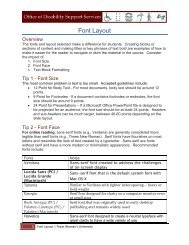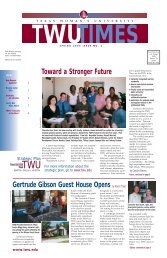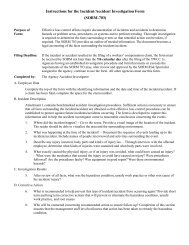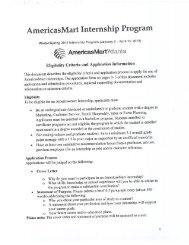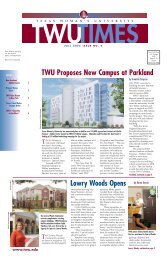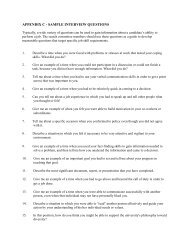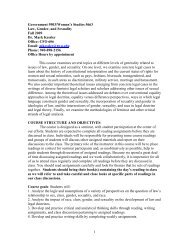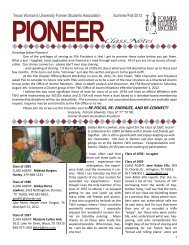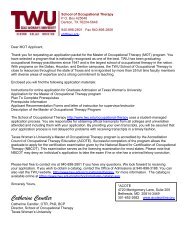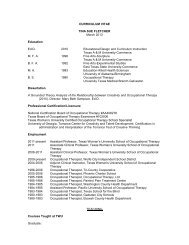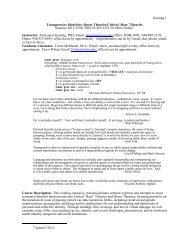Down Syndrome
Down Syndrome
Down Syndrome
Create successful ePaper yourself
Turn your PDF publications into a flip-book with our unique Google optimized e-Paper software.
APE FACT SHEET<br />
DOWN SYNDROME<br />
DEFINITION:<br />
<strong>Down</strong> syndrome is the most common and readily identifiable chromosomal condition<br />
associated with mental retardation. It is caused by a chromosomal abnormality; for some<br />
unexplained reason, an accident in cell development results in 46 instead of the usual 45<br />
chromosomes. This extra chromosome changes the orderly development of the body and<br />
brain. In most cases, the diagnosis of <strong>Down</strong> syndrome is made according to results from a<br />
chromosome test generally administered shortly after birth.<br />
INCIDENCE:<br />
One in 1,000 live births.<br />
Associated with advanced maternal age, particularly if over 35 years of age.<br />
One in 80 infants born from women older than 40 years of age.<br />
Parents of any age may have a child with <strong>Down</strong> syndrome.<br />
Although only 5 to 8% of pregnancies occur in women over the age of 35, they account<br />
for 20% of <strong>Down</strong> syndrome births.<br />
There is no association between <strong>Down</strong> syndrome and any given culture, ethnic group,<br />
socioeconomic status, or geographic region.<br />
POSSIBLE PHYSICAL CHARACTERISTICS:<br />
Physical appearances<br />
Flat-bridged nose<br />
Looseness of joints<br />
Lack of muscle tone during infancy<br />
Palmer crease (a normal groove across the palm of the hand)<br />
Protruded abdomen<br />
Short fingers, limbs, and neck<br />
Short stature<br />
Slanting, almond-shaped eyes<br />
Small oral cavity; enlarged or protruding tongue<br />
Small scull<br />
Structural abnormalities of the lungs, nasal passages, airways and chest walls could<br />
affect breathing in strenuous exercise<br />
Substantial delays in reflex integration<br />
Tendency to be overweight<br />
Tendency to have antlantoaxial instability (AAI) – a misalignment of the first two<br />
cervical vertebrae of the neck<br />
French, R. (1997 – 2004)
Varied levels of mental retardation<br />
Motor problems<br />
Decreased ability in kinesthetic awareness (the ability to obtain information regarding<br />
the position and movement of the body in space)<br />
Significant decreases in static and movement balance<br />
Other diseases<br />
Heart disease; 40 to 60% of infants with DS have significant congenital heart disease<br />
Susceptibility to pulmonary problems<br />
Poor eyesight<br />
Most common disorders are near sightedness and cross-eyed or squint<br />
Constant movement of the eyeball<br />
Motor problems are intensified by visual disorders<br />
Poor hearing<br />
Maybe auditory perceptual deficits – an inability to locate sound or distinguish<br />
between two sounds<br />
Hearing loss results in difficulty in learning to speak and follow instructions<br />
TEACHING TIPS:<br />
Adapt cardiovascular activities.<br />
Adapt activities involving movement on uneven surfaces.<br />
Adapt activities involving agility and changing directions.<br />
An alternative method of communication may be necessary.<br />
Avoid activities that place the neck in extreme flexion, such as tumbling, in<br />
individuals who test positive for AAI.<br />
Check medical records and follow written guidelines established by the physician.<br />
Coordinate with medical community to prevent contraindications.<br />
Discourage hyperflexible postures.<br />
Determine cause of problem with other health professionals.<br />
Encourage muscular strengthening especially around joints.<br />
Incorporate family into solution.<br />
Proper nutrition and weight control should be stressed.<br />
Provide calorie burning activity.<br />
Stress personal care (i.e., wearing weather appropriate clothing, getting enough to<br />
drink) and hygiene (washing hands and face frequently).<br />
Stress activities like sitting, crawling, walking, and moving through various positions<br />
to increase muscle strength.<br />
Teach them to move or touch particular body part.<br />
Utilize visual demonstrations.<br />
Utilize tactile demonstrations.<br />
French, R. (1997 – 2004)
Use visual cues or stimulate visual tracking and acuity.<br />
Use auditory cues or require listening to complete.<br />
ATLANTOAXIAL INSTABILITY (AAI):<br />
Atlantoaxial Instability (AAI), also referred to as atlantoaxial subluxation, is a condition<br />
where there is increased mobility or movement between the first and second cervical<br />
vertebrae (segments of the spine in the neck). Various researchers have estimated that this<br />
condition occurs in 15% of children with <strong>Down</strong> syndrome. AAI is usually diagnosed with<br />
x-rays of the cervical spine, but typically does not produce noticeable symptoms. Symptoms<br />
are usually seen only when subluxation (incomplete or partial dislocation) of the joint<br />
between the first and second cervical vertebrae.<br />
SIGNS AND SYMPTOMS OF AAI:<br />
Changes in bowel or bladder function<br />
Difficulty walking<br />
Weakness of any extremities<br />
Changes in neck posturing, neck pain, or limitations of neck movement<br />
Progressive clumsiness and loss of coordination<br />
Hypersensitivity<br />
Extensor plantar responses (abnormalities detected in the neurological examinations)<br />
PRECAUTIONARY MEASURES:<br />
Have x-rays on school file prior to participation in physical activity.<br />
Check medical files, speak with parents, and adhere to physician’s recommendations.<br />
Restrict participation in gymnastics, diving, butterfly stroke in swimming, high jump,<br />
soccer, and any warm-up exercises that places pressure on the muscles of the neck<br />
(may participate with written clearance from a physician).<br />
Information on this sheet contains only suggested guidelines. Each student must be<br />
considered individually, and in many cases, a physician’s written consent should be<br />
obtained.<br />
French, R. (1997 – 2004)




